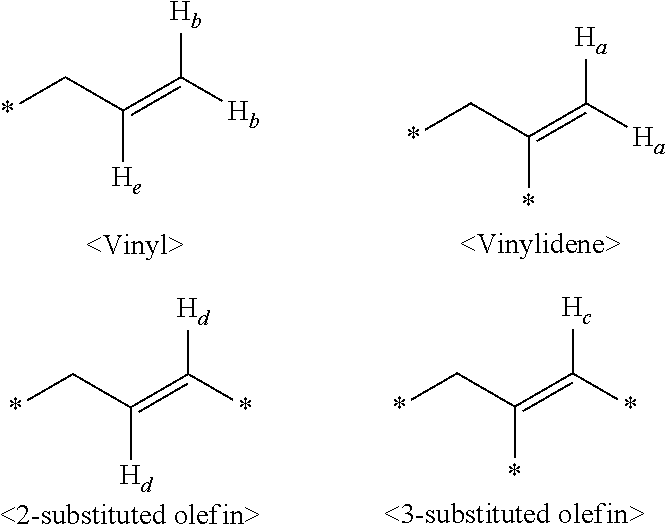Adhesive including ethylene ·α-olefin copolymer
a technology of ethylene -olefin and copolymer, applied in the field of adhesives, can solve the problems of failure to indicate whether the heat stability of the adhesive is satisfactory or not, and achieve the effect of improving heat stability and adhesion
- Summary
- Abstract
- Description
- Claims
- Application Information
AI Technical Summary
Benefits of technology
Problems solved by technology
Method used
Image
Examples
production example 1
[0153]A polymerization device made of stainless steel and equipped with an agitating blade with a substantial inner volume of 1 L (number of agitating rotations=500 rpm) was used. In the device filled with liquid, ethylene was continuously copolymerized with 1-butene at a polymerization temperature of 95° C. Through a side portion of the polymerization device to the liquid phase, 0.30 L of hexane, 85 g of ethylene and 160 g of 1-butene, together with 0.1 NL of hydrogen, 0.00035 mmol of bis(1,3-dimethylcyclopentadienyl) zirconiumdichloride, 0.053 mmol in terms of aluminum of a methylaluminoxane / hexane solution and 0.26 mmol of triisobutylaluminum, per hour, were continuously fed. With a polymerization pressure kept at 3.8 MPaG, the copolymerization reaction was thus performed. The hexane solution of ethylene 1-butene copolymer continuously obtained was stored at a holding drum, and thereto 0.3 ml per hour of methanol as a catalyst inactivator was added in order to terminate the polym...
production example 2 to 3
[0156]Production Example 1 was repeated except that in Production Example 1 the 1-butene feed amount and the hydrogen feed amount were changed, resulting in providing ethylene.1-butene copolymers (polymers B and C).
production example 4
[0157]A polymerization device made of stainless steel and equipped with an agitating blade with a substantial inner volume of 1 L (number of agitating rotations=500 rpm) was used. In the device filled with liquid, ethylene was continuously copolymerized with 1-butene at a polymerization temperature of 95° C. Through a side portion of the polymerization device to the liquid phase, 0.23 L of hexane, 70 g of ethylene, 230 g of 1-butene, together with 0.1 NL of hydrogen, 0.00033 mmol of bis(1,3-dimethylcyclopentadienyl) zirconiumdichloride, 0.050 mmol in terms of aluminum of a methylaluminoxane / hexane solution and 0.25 mmol of triisobutylaluminum, per hour, were continuously fed. With a polymerization pressure kept at 3.8 MPaG, the copolymerization reaction was performed. The hexane solution of ethylene.1-butene copolymer continuously obtained was stored at a holding drum, and thereto 0.3 ml per hour of methanol as a catalyst inactivator was added in order to terminate the polymerizatio...
PUM
| Property | Measurement | Unit |
|---|---|---|
| Density | aaaaa | aaaaa |
| Density | aaaaa | aaaaa |
| Density | aaaaa | aaaaa |
Abstract
Description
Claims
Application Information
 Login to View More
Login to View More - R&D Engineer
- R&D Manager
- IP Professional
- Industry Leading Data Capabilities
- Powerful AI technology
- Patent DNA Extraction
Browse by: Latest US Patents, China's latest patents, Technical Efficacy Thesaurus, Application Domain, Technology Topic, Popular Technical Reports.
© 2024 PatSnap. All rights reserved.Legal|Privacy policy|Modern Slavery Act Transparency Statement|Sitemap|About US| Contact US: help@patsnap.com










